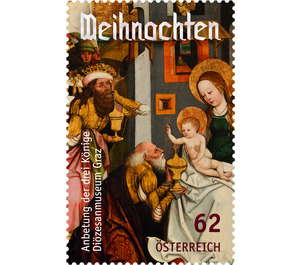Christmas - Austria / II. Republic of Austria 2014 - 62 Euro Cent
Theme: Religion & Spirituality
| Country | Austria / II. Republic of Austria |
| Issue Date | 2014 |
| Face Value | 62.00 |
| Edition Issued | 2,350,000 |
| Printing Type | offset |
| Stamp Type | Commemorative |
| Item Type | Stamp |
| Chronological Issue Number | 2511 |
| Chronological Chapter | OOS-OE2 |
| SID | 956962 |
| In 77 Wishlists | |
Reverently, the elder king kneels before the baby Jesus and holds out his gift to him. Christ extends his hand to bless him, while Mary looks at him proudly and adds more homage. "Adoration of the Magi" from the Diocesan Museum Graz is a Gothic representation of this Bible scene, it was painted with oil on wood and is part of a former winged altar. This was erected as a high altar on the northern choir wall of the parish church Hirschegg in Styria, before the wood panel painting was handed over in 1932 to the Diocesan Museum Graz. The altarpiece is painted on both sides: On the one side is the condemnation of Jesus and the hand washing of Pilate, on the other side just the "Adoration of the Magi". The latter may have been on the so-called "Sunday" of the altar, which, according to the Director of the Diocesan Museum Graz, Heimo Kaindl, due to the richly decorated with relief carving red frame and the gilded image background with brocade pattern is adopted. The tradition of winged altars was created when additional pictures were attached to blackboard images on the sides in order to hide the main picture during Lent, for example. "Adoration of the Magi" is not clearly attributable to an artist, but due to the malleability of the forms and the softening of hard-edged folds, it is believed that it comes from the circle of the image carver Hans Klocker. He was the director of a large workshop that made complete altars, including figures and paintings. The workshop of the artist, who worked in the last third of the 15th century, held a monopoly position in Bressanone in South Tyrol, including altars for Tramin, Passeier, Brixen and for the Franciscan church in Bolzano. Although Klocker was documented as a carver and painter, but was probably mainly active in the first function. He achieved such a high reputation as an artist that he was eventually elected Mayor of Bressanone. In the present picture from the altar of Hirschegg the oldest king is portrayed as a man with a white beard and sparse hair, the second a little younger, the third king even younger and with black skin. Other admirers seem to crowd to the baby Jesus sitting under a canopy pointing to the stable in Bethlehem. In the work from which a fragment was used for the present stamp, also the holy Joseph and the star, who led the kings, are to be seen. According to the director of the Diocesan Museum Graz, the reference to the three kings shown is of different ages and origins "that this Jesus Christ was born into this world for all people, regardless of their age, status or nationality has been".


